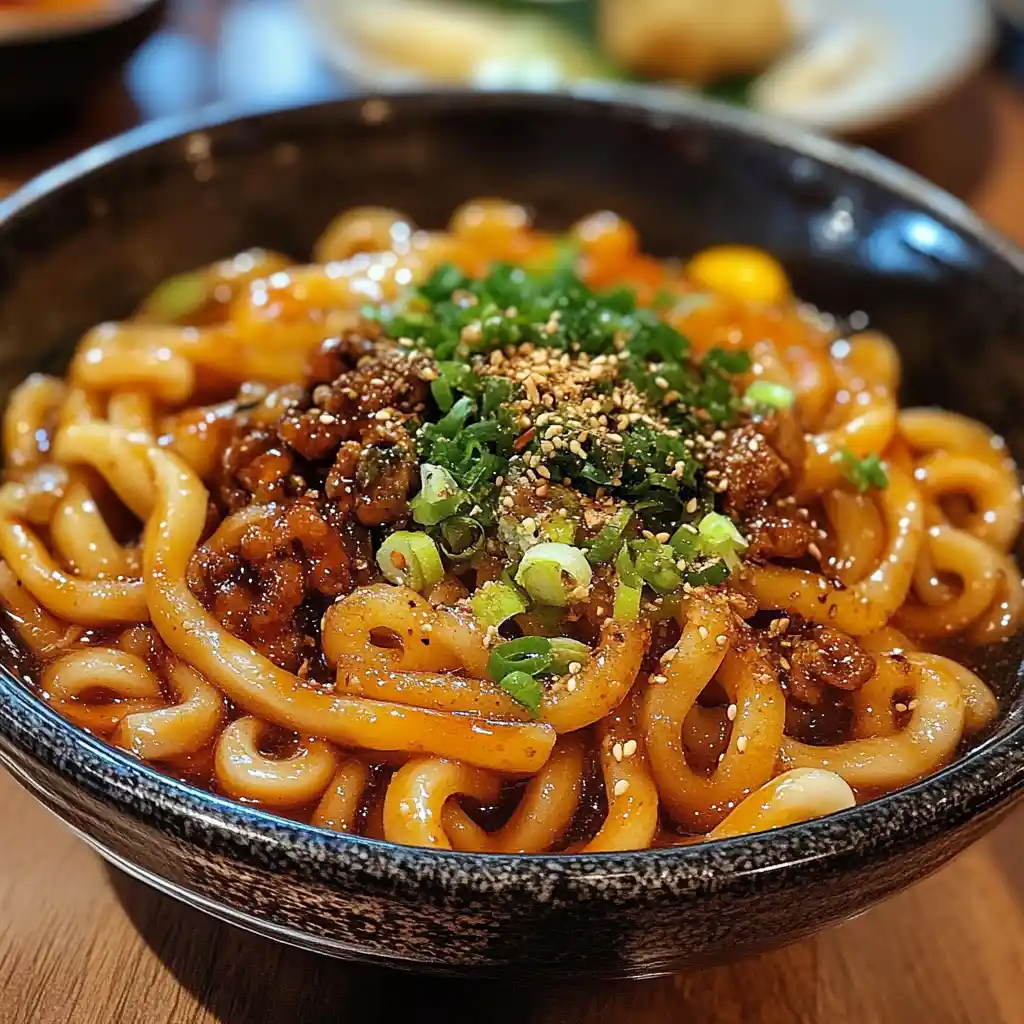Authentic Yaki Udon Recipe

Yaki Udon is a beloved Japanese stir-fried noodle dish that combines thick, chewy udon noodles with fresh vegetables, savory proteins, and a flavorful soy-based sauce. Unlike ramen or soba, udon noodles are wide, soft, and satisfyingly chewy, making them the perfect base for a hearty meal. This dish originated in post-war Japan when noodles were stir-fried with available ingredients, and today it has become a popular comfort food found in Japanese homes, street stalls, and restaurants worldwide.
The beauty of Yaki Udon lies in its versatility you can make it vegetarian, seafood-based, or meat-heavy depending on your taste and pantry. With just a handful of ingredients and under 30 minutes of cooking, you’ll have a flavorful one-pan meal ready to enjoy.
Whether you’re new to Japanese cooking or already love stir-fried noodles, this easy Yaki Udon recipe will become a go-to weeknight dinner in your kitchen.
❤️ Why You’ll Love This Recipe ?
- Quick & Easy – Ready in under 30 minutes, making it perfect for weeknight dinners.
- Customizable – Works with chicken, beef, shrimp, tofu, or just veggies.
- Authentic Flavor – A delicious soy-based sauce coats the noodles beautifully.
- Comforting & Satisfying – Thick, chewy udon noodles make every bite hearty.
- Minimal Ingredients – Uses pantry staples and fresh produce you likely already have.
🥢 What Do You Need to Prepare Yaki Udon? (Ingredients)
Here’s everything you’ll need to make this flavorful Japanese stir-fried udon recipe:
For the Stir-Fry:
- 14 oz (400g) fresh or frozen udon noodles (or pre-cooked udon packets)
- 2 tbsp vegetable oil (or sesame oil for extra flavor)
- 1 small onion, thinly sliced
- 2 cloves garlic, minced
- 1 small carrot, julienned
- 1/2 small cabbage, shredded
- 1 bell pepper (red or yellow), thinly sliced
- 6 oz (170g) protein of choice (chicken, beef, pork, shrimp, or tofu)
- 2 green onions, chopped (for garnish)
- 1 tbsp sesame seeds (optional)
For the Yaki Udon Sauce:
- 3 tbsp soy sauce
- 2 tbsp oyster sauce
- 1 tbsp mirin (or substitute with rice vinegar + pinch of sugar)
- 1 tsp sugar
- 1 tsp sesame oil
- Optional: 1 tbsp Worcestershire sauce for extra depth
👩🍳 How to Make Easy Yaki Udon Step-by-Step ?
Step 1: Prepare the Udon Noodles
- If using frozen udon, place them in boiling water for 2–3 minutes until loosened.
- Drain and rinse with cold water to stop cooking.
- Set aside.
Step 2: Prepare the Sauce
- In a small bowl, whisk together soy sauce, oyster sauce, mirin, sugar, sesame oil, and Worcestershire (if using).
- Set aside.
Step 3: Cook the Protein
- Heat 1 tbsp of oil in a large skillet or wok over medium-high heat.
- Add your chosen protein (chicken, beef, shrimp, or tofu) and cook until golden and fully cooked through.
- Remove from pan and set aside.
Step 4: Stir-Fry the Vegetables
- In the same pan, add another tablespoon of oil.
- Stir-fry onions, garlic, carrots, bell pepper, and cabbage for 3–4 minutes until slightly tender but still crisp.
Step 5: Combine Everything
- Add the cooked protein back into the pan.
- Toss in the udon noodles and pour the prepared sauce over everything.
- Stir-fry for 2–3 minutes, ensuring the noodles absorb the sauce evenly.
Step 6: Garnish & Serve
- Sprinkle with chopped green onions and sesame seeds.
- Serve hot straight from the wok.
🔄 Variations
One of the best things about Yaki Udon is its adaptability. You can create countless variations depending on your taste, dietary needs, or what’s in your fridge. For a vegetarian version, swap the meat with firm tofu or mushrooms like shiitake or oyster mushrooms for a rich umami kick. Seafood lovers can use shrimp, squid, or scallops for a lighter, ocean-inspired dish. If you prefer spicy flavors, add chili paste, sriracha, or Japanese togarashi seasoning to the sauce for extra heat.
For a healthier version, load your stir-fry with more vegetables such as broccoli, snap peas, or bok choy. You can also make it gluten-free by using tamari instead of soy sauce and ensuring your oyster sauce alternative is gluten-free. Another creative twist is adding an egg—either scrambled directly into the noodles or fried sunny-side-up and placed on top.
Street food vendors in Japan often serve Yaki Udon with bonito flakes (katsuobushi) sprinkled on top, which adds smoky, savory depth. Feel free to experiment with different toppings like pickled ginger, nori strips, or even kimchi for a Korean-Japanese fusion. This dish truly adapts to any flavor profile while maintaining its signature chewy, saucy appeal.
📝 Cooking Note
When making Yaki Udon, timing is key. Udon noodles should be cooked just enough to loosen but not overboiled, or they may lose their chewy texture. Always rinse cooked noodles under cold water to stop them from sticking together. If you use pre-cooked udon, you can skip boiling and simply add them directly into the stir-fry once the vegetables are done.
A good wok or large skillet makes a difference since the wide surface allows vegetables and noodles to cook evenly without steaming. Stir-frying requires high heat, so keep all ingredients prepped and ready before you start cooking. This quick cooking method ensures vegetables remain crisp, proteins stay juicy, and noodles soak up the savory sauce without turning mushy.
Balancing flavors is another important aspect. Soy sauce adds saltiness, oyster sauce adds umami, mirin or rice vinegar brings sweetness, and sesame oil adds nuttiness. Taste the sauce before adding it to the noodles and adjust to your preference. If you want a smokier, more intense flavor, a dash of Worcestershire sauce is highly recommended.
Remember, Yaki Udon is a flexible dish—you don’t have to follow the recipe strictly. Use what you have on hand, and it will still turn out delicious.
🍽️ Serving Suggestions
Yaki Udon is best served hot, straight from the wok, while the noodles are still springy and glossy with sauce. It makes a complete meal on its own, but you can also pair it with other Japanese dishes for a full dining experience. Consider serving it with miso soup, gyoza (Japanese dumplings), or a light cucumber salad for balance.
For extra indulgence, top your Yaki Udon with a fried egg, bonito flakes, or shredded nori. If serving to guests, present it family-style in a large bowl so everyone can help themselves. Pair it with green tea or chilled sake for an authentic touch. This dish also works great as a quick lunch or as a satisfying late-night meal after a busy day.
💡 Helpful Tips
- Don’t Overcook Udon: Udon noodles should be chewy. Overboiling makes them mushy.
- Prep Before Cooking: Stir-fry is fast. Have all veggies chopped and sauce mixed before heating the pan.
- Use High Heat: Stir-frying requires strong heat for that slightly smoky flavor.
- Protein First: Always cook meat or tofu before adding vegetables to avoid overcooking.
- Adjust Sauce: Taste and tweak sweetness, saltiness, and umami to your preference.
- Oil Matters: A touch of sesame oil enhances flavor, but don’t use too much or it will overpower the dish.
- Noodle Separation: If noodles clump, rinse briefly in warm water before adding to the wok.
- Fresh Garnishes: Green onions, sesame seeds, and nori strips add freshness and texture.
- Make Ahead: You can prep vegetables and sauce in advance for quicker cooking.
- Storage: Store leftovers in an airtight container for up to 2 days. Reheat in a pan, not the microwave, for best texture.
⭐ Tips for the Best Yaki Udon
For the most flavorful Yaki Udon, always use fresh or frozen udon noodles instead of dried—they provide the best chewy texture. Make sure your pan or wok is large enough to allow all ingredients to stir-fry evenly without overcrowding. The sauce should be added gradually, tossing the noodles as you go, so every strand gets coated without becoming soggy.
Another secret to the best Yaki Udon is using a mix of textures. Crunchy vegetables, tender meat or tofu, and springy noodles balance beautifully. For extra umami, add mushrooms or a splash of dashi stock to the sauce. Finally, serve immediately Yaki Udon doesn’t wait, and it tastes best when eaten hot and fresh.
🕒 Timing Overview
- Prep Time: 10 minutes
- Cooking Time: 15 minutes
- Total Time: 25 minutes
🥗 Nutritional Information (Approx. per serving)
- Calories: 430 kcal
- Protein: 18 g
- Sodium: 890 mg
- Carbohydrates: 65 g
- Fat: 10 g
- Fiber: 5 g
❓ FAQs
Q1: Can I make Yaki Udon vegetarian?
Yes! Replace the meat with tofu or mushrooms and use vegetarian oyster sauce alternatives.
Q2: What’s the difference between Yaki Udon and Yakisoba?
Yakisoba uses thinner wheat noodles, while Yaki Udon uses thick, chewy udon noodles.
Q3: Can I use dried udon noodles?
Yes, but fresh or frozen udon gives the best chewy texture. If using dried, cook them until al dente before stir-frying.
Q4: How do I store leftovers?
Keep in an airtight container in the fridge for up to 2 days. Reheat in a skillet with a splash of water.
Q5: Is Yaki Udon spicy?
Traditionally, it isn’t spicy, but you can add chili paste, sriracha, or togarashi if you like heat.
🏁 Conclusion
Yaki Udon is the perfect combination of chewy noodles, crisp vegetables, savory protein, and a flavorful sauce. This dish is quick, versatile, and endlessly satisfying, making it a staple in Japanese home cooking and street food. With just 25 minutes of your time, you can recreate an authentic taste of Japan right in your kitchen.
Whether you enjoy it plain, spicy, or topped with unique garnishes, Yaki Udon is guaranteed to become a favorite in your weekly meal rotation.

